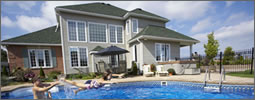Vinyl siding is one of the most popular exterior options for residential buildings, and with good reason – there are many worthwhile reasons to choose vinyl over other materials. Everything from durability and maintenance requirements to siding prices and aesthetic features factors into homeowners’ decisions about the type of exterior cladding to choose for their homes, and vinyl siding scores high in many categories.


Here Are 10 Reasons To Consider Vinyl Siding

Lots Of Options
Homeowners have a ton of different options, including different styles, different siding colors, different looks, different finishes and even different applications. Here are some of the options of you may want to consider:

Styles:
• Clapboard or Dutch Lap
• Cedar and Cedar Shake
• Hand Split and Hand Split Variegated
• Brick, Wood or Log Siding
• Board And Batten
• Straight edge, Staggered or Half Round Shingle

Applications:
• Liquid
• Insulated
• Seamless

Finishes
• Matte
• Glossy
• Textured

2. The Cost Of Vinyl Siding
Cost is a big factor in why this siding option is so popular. It is generally the least expensive option for siding your home, in comparison to other materials such as stone, wood, brick, aluminum or stucco. Of course, cost is not the only factor that people consider, and there is a wide variety of price points when it comes to different styles and installations. But, as a general rule of thumb, you can expect to pay about $3 – $7 per sq. ft., plus installation.

3. High Return On Investment
The return on investment, or ROI is high (over 80%), making it a smart investment in your home. In fact, it can offer a higher ROI than almost any other type of home improvement project you can tackle. If you install insulated siding, your ROI can be even higher, due to increased energy efficiency and lower energy bills, although the initial investment will also cost more. A newly sided home looks better and appears well cared for and well maintained, making it easier to attract potential buyers when it is time to sell.

4. Aesthetic Value
Installing vinyl siding on your home can add greatly to its aesthetic value. It is available in a wide array of styles, colors and finishes to create any look you desire. Vinyl siding can completely transform the look of your home, or it can simply make it look more updated and fresher. Either way, you can reap the reward of great looks on a relatively limited budget.

5. Great Color Selection
When it comes to the variety of colors available, nothing comes close to the selection that vinyl siding offers. From white and beige, to deep reds, rich earth tones and bold blues, homeowners are bound to find a color selection to complement the style of their home, as well as the desired look. It’s important, however, to choose colors carefully and to ensure that the color you choose will look good in all types of lighting situations. It’s also best to remember that this is a long term purchase so you should select a siding color that you think you can live with for many years.

6. Handles All Types Of Weather
Most types can handle extreme temperatures, as well as changeable temperatures, with no damage. Quality products are resistant to fading from the sun and some even reflect heat, which can lower your energy bills when the temps start to soar. It is also resistant to strong winds and is water and moisture resistant, so it holds up better when it’s stormy outside.

7. Low Maintenance Requirements
Vinyl siding requires virtually no maintenance at all to keep it looking its best. All that is needed is an occasional cleaning, which can be accomplished with a hose. In some cases, stuck on dirt and debris may require some light scrubbing and mild detergent, but that’s it. In contrast, other siding choices such as wood and stucco need to be repainted and resealed periodically, which can be a huge job. Brick and stone may need to occasionally be repointed or regrouted.

8. Easy Installation
The process of installing vinyl siding is relatively easy. It often comes with a locking system so that each piece locks into the adjoining piece of siding or a starter piece and then the edge of the siding is loose-nailed to the wall. Siding boards also come in relatively long lengths, so once the initial row of siding is installed and is leveled, the rest of the siding can be installed fairly quickly and easily.

9. Easily Repaired
If your vinyl siding happens to get damaged, whether from extreme weather or a ball that’s thrown against it, it can be easily repaired. All you need to do is to pop out the damaged piece of siding and put a new one in its place. It is best to keep a few extra pieces on hand, if possible, so should the need to replace the panels arise, you will have a color-matched piece of siding to use as a replacement.

10. Long Term Durability
It is a very durable product that will last for years and years. It will typically last longer than wood panels, which can rot or become damaged from water, mold, mildew, insects, or long-term exposure to the sun. It won’t dent, scratch or rust like aluminum siding can. It won’t flake or chip like stucco can. Vinyl siding is not quite as durable as stone or brick, however, but it is also not as expensive to install.


